Variety in Fabrics
- Books Name
- Class 6 Science Book
- Publication
- PathSet Publications
- Course
- CBSE Class 6
- Subject
- Science
VARIETY IN FABRICS
Clothes are made of different materials. We get these materials from both plants and animals.
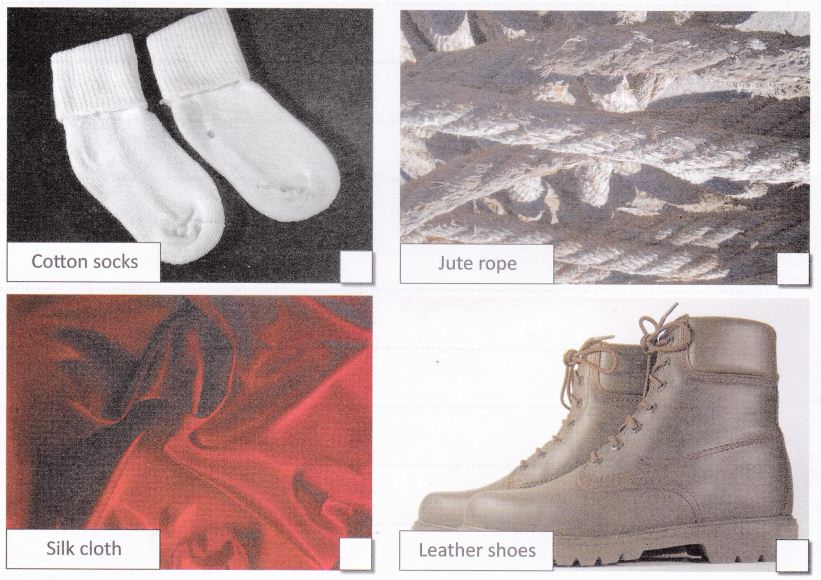
Fiber And Fabric:
Clothes are made mostly from fibres. Fibres are thin strands of thread, that are woven to make fabric, for example, cotton fabric, silk fabric, etc. The fabric is stitched to make clothes. For example, cotton fabric can be stitched into a cotton frock or a cotton kurta.
Yarn: Yarn is defined as a long, twisted and continuous strand composed of interlocked fibers or filaments which are used in knitting and weaving to form cloth.
Fibre
- Books Name
- Class 6 Science Book
- Publication
- PathSet Publications
- Course
- CBSE Class 6
- Subject
- Science
Fibers
All Cloth materials are made up of long, narrow, thin structures called fibers.
The thin threads or filaments which form a yarn are called Fibres.
Fibers are obtained from natural as well as man-made sources.
Fibres:

Where do Fibres come from?
Fibres can be broadly classified into two broad categories:
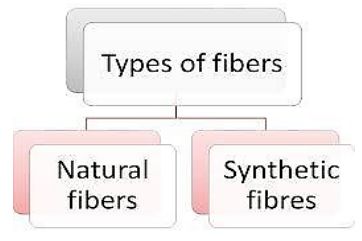
Natural Fibres: Fibres that come from plants and animals i.e. are found in nature are called Natural Fibres. Examples:
We get jute and cotton from plants.
Wool is acquired from the fleece of a goat and sheep. It can also be acquired from the hair of yak, rabbits and camels.
The process involved in making Animal Fibre into wool follows a series of steps — Shearing, Scouring, Sorting, Cleaning, Dyeing, Straightening, Rolling and Combing.
Silk Fibre can be procured from the cocoon of silkworms. The process of obtaining Silk from Silkworm is called Sericulture.
Synthetic Fibres: Fibres that are made of chemical substances i.e. substances not found directly in nature are classified as synthetic fibres. Examples include nylon, acrylic and polyester.
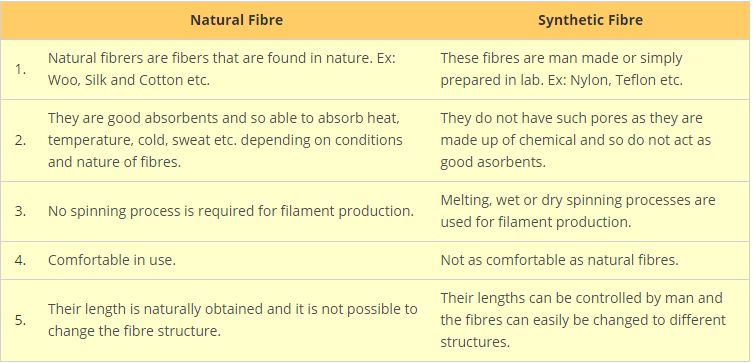
Spinning Cotton Yarn
- Books Name
- Class 6 Science Book
- Publication
- PathSet Publications
- Course
- CBSE Class 6
- Subject
- Science
Spinning Cotton Yarn
- Spinning: Spinning is the process of constructing yarn from fibres in which fibres from a huge heap of cotton wool are taken out and twisted which brings them together to form a yarn.
- There are two major devices called Takli which is a hand spindle and Charkha which is also a hand-operated device, are used for spinning.
- Charkha: Charkha is a machine on which yarn was spun directly from ginned cotton in olden days.
- The spinning of yarn on a bigger scale is done using spinning machines following which these yarns are used to weave fabric.
- Khadi was the term used to denote clothes which were made from homespun yarn.
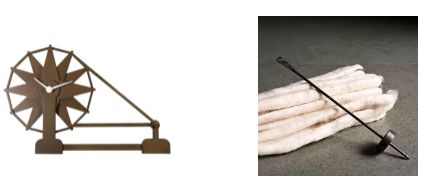
- On the left we can see a charkha and on the right we can see a simple takli.
Some Plant Fibres
- Books Name
- Class 6 Science Book
- Publication
- PathSet Publications
- Course
- CBSE Class 6
- Subject
- Science
Some Plant Fibres
Cotton (Fig. 4.3), jute, coir, silk cotton, hemp, and flax are examples of plant fibres. Denim, used to make jeans, is made from cotton.
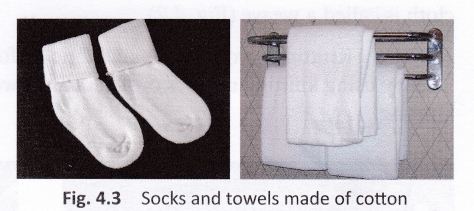
Cotton:
The cotton plant is a shrub. It grows well in black soil and warm climate. It needs moderate rainfall. Cotton is a soft fibre that grows around the seeds of the cotton plant. A variety of textile products are made from cotton. In India, ‘lchadi’, a coarse hand-woven cloth, is made from cotton.
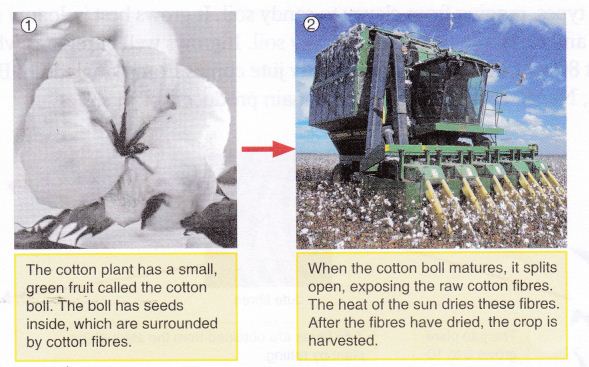
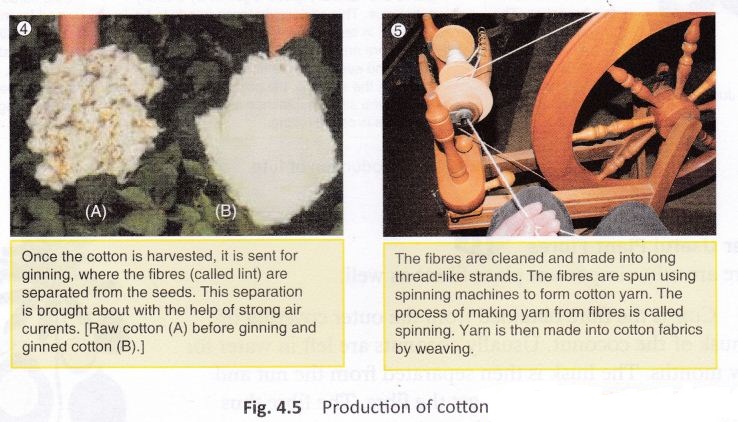
- Cotton plants are grown in fields usually at places having a warm climate and black soil.
- Some cotton producing Indian states are Punjab, Gujarat, Madhya Pradesh, Karnataka, Maharashtra etc.
- Cotton plants bear fruits the size of a lemon called Cotton Balls which burst open upon maturing and the seeds wrapped up in cotton fibre become visible. Cotton is generally picked by hand from these balls.
Ginning: Ginning of cotton can be defined as the process of separating cotton fibres from cotton seeds. Traditionally, ginning used to be done by hand but these days machines called double roller cotton ginning machines are widely in use.
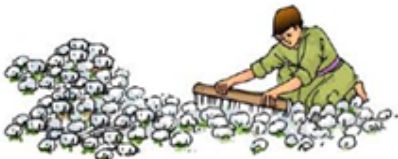
In the above figure, we see a boy ginning by hand.
2. Jute
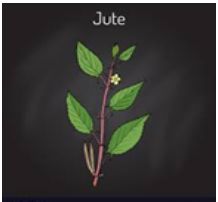
A jute plant
Jute:
Jute is a fibre obtained from the bark of the jute plant (Fig. 4.6).
- It can be grown in different soil types, ranging from clayey to sandy soil.
- It grows best in loamy soil (mixture of sand, silt, and clay), sandy soil, and clayey soil.
- It grows well in regions where it rains a lot.
- Almost 80% of the world’s high-quality jute comes from Bangladesh. Bangladesh, India, China, Nepal, and Thailand are the main producers of jute.
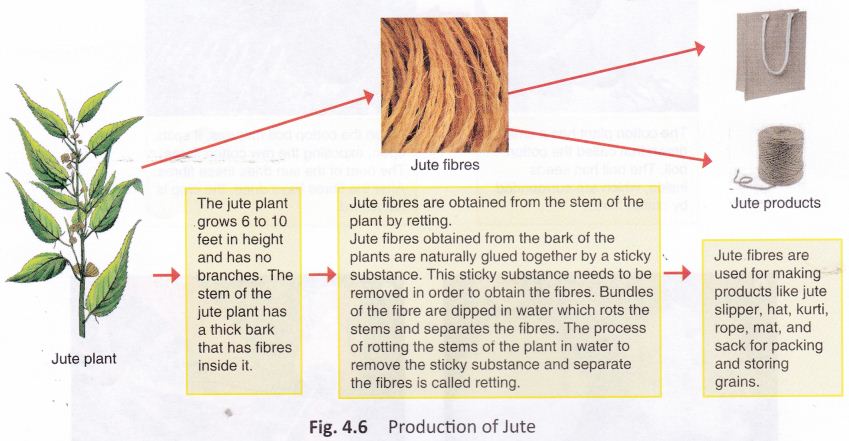
- Jute fibre is obtained from the stem of the plant.
- Unlike cotton, jute is cultivated in the rainy season.
- Some jute producing Indian states are Bihar, Assam and West Bengal.
- The plant is harvested during its flowering stage.
- The stems of these harvested plants are then soaked in water for four to five days
- The stems are left to rot and then the fibres are picked out by hand.
- Yarn: Yarn is the spun thread that is made from fibres in order to produce a fabric.
- Other Useful Plant Fibres:
There are other important plant fibres as well. - Coir: Coir is the fibre obtained from the outer covering or the husk of the coconut. Usually coconuts are left in water for a few months. The husk is then separated from the nut and beaten with wooden mallets to get the fibre. The fibre thus obtained is spun and dyed and is ready for weaving. Coir is used to make several household products like rope and floor covering and also as a stuffing in mattresses and pillows.

- Silk cotton: Silk cotton is another plant fibre that is commonly used as a stuffing in pillow, sleeping bag, and life jacket. This fibre is obtained from the silk cotton tree, also called kapok.
The fruits of the kapok tree contain fibres that are light and fluffy (like cotton). When the fruit ripens, it bursts open, releasing the fibres. - Hemp: Hemp fibres are obtained from the stem of the hemp plant. Hemp fibres are used in the production of ropes, carpets, nets, clothes, and paper.
Flax Fibres obtained from the stem of the flax plant are woven to make a fabric called linen. Flax fibres are also used in the production of rope and high-quality paper.
Yarn to Fabric
- Books Name
- Class 6 Science Book
- Publication
- PathSet Publications
- Course
- CBSE Class 6
- Subject
- Science
Yarn to Fabric
There are many ways by which fabrics are made from yarns. The two main processes are weaving and knitting. The process of arranging two sets of yarns together to make a fabric is called weaving.
Weaving and knitting are used for making different kinds of fabric. These fabrics are used for a variety of clothing items.
Weaving: The process of entwining two sets of yarn simultaneously to make fabric is called Weaving. The process is done using a loom (which can either be operated by hand or by a machine) which interlaces two sets of yarn at right angles to each other.
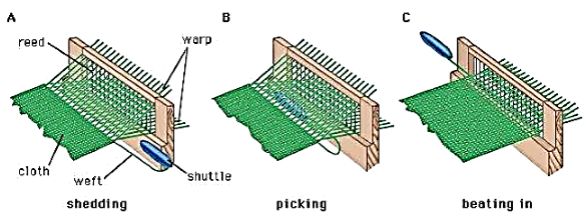
The above figure represents the process of weaving.
- Knitting: Knitting is the process by which a single strand of yarn is used to make a piece of fabric. Socks, sweaters, mufflers and a lot of other winter clothes are made of knitted fabrics. Knitting can be done by hand as well as by machines.
- Knitting involves making fabric by forming a series of connected loops of yarn by using knitting needles or machines. Sweaters are made from wool strands by knitting.
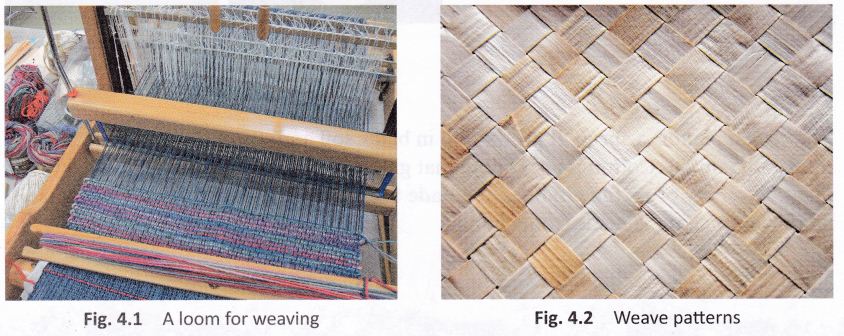
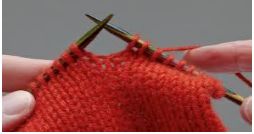
History of clothing material
- Books Name
- Class 6 Science Book
- Publication
- PathSet Publications
- Course
- CBSE Class 6
- Subject
- Science
History of Clothing Material
- History Of Clothing:
About 30,000 years ago, people started using animal skins for clothing. - It is believed that wool was used as early as 6000 years ago.
Domestication of silkworms to produce silk occurred around 3000 BC in China. In India, cotton came into widespread use around 3000 BC. These fabrics were not stitched. - They were just wrapped around the body. Even today, sari, dhoti, and turban are unstitched pieces of cloth.
- During ancient times, people were not civilized and they used to live in the forest without any clothes.
- As time passed, humans to protect themselves from the harsh climatic condition, they started to cover their body using bark and big leaves of trees or animal skins and furs.
- Gradually, humans learnt to make large pieces from grass and plant fibres to cover their waist, nowadays it is known as a skirt. Further, they started to make robes like outfits using animal hairs.
- Revolution started once the needle was invented, people started to make the clothes from all sorts of fabrics available.
- Today fabrics are used extensively to decorate windows and curtains with beautiful windows. And also table clothes and bedsheets which makes the interior more attractive.
- Clothes of different designs, colours, and shapes are available today for clothing. Textile industries are one of the largest industries in today’s world.
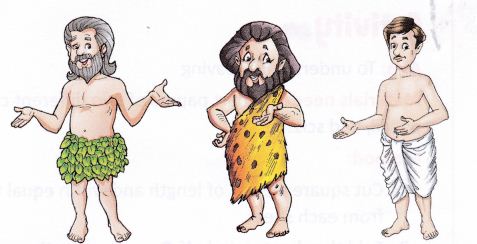
- In earlier times, when people did not have access or the knowledge to process fibre, big leaves and the bark of trees were used by people to cover themselves.
- After settlement began in agricultural communities, they learnt how to weave. They used grass and twigs to make mats and baskets. Animal hair or fleece and vines were warped together into stretched out strands which were then woven into fabrics.
- There was an abundant growth of cotton in areas near Ganga, which the early Indians readily used to make fabrics for themselves.
- There is another plant named flax which yields natural fibres.
- The early Egyptians cultivated both cotton and flax and used them for creating fabrics. These plants grew near the river Nile.
- But in those days, people were not aware of the process of stitching. They simply used to wrap around the fabric around different parts of their bodies. Even today unstitched clothes like sarees, dhotis, lungis or turbans are widely in use.
- It was with the advent of the sewing needle that people learnt how to stitch fibres to make fabric.
Summary
Natural Sources: Cotton, jute, silk, wool, etc., are obtained from natural sources- plants or animals.
Man-made Sources: Polyester, nylon, rayon etc., are man-made materials used for making clothes.
Plant fibres: All the plants have fibres in their body structure, e.g., cotton and mango have fibres on their seed, coconut on its fruit, jute in its stem and banana tree in its leaf.
Animal fibres: Important animal fibres are wool (hair of sheep) and silk (from silkworm).
Yarn: Yarn is defined as a long, twisted and continuous strand composed of interlocked fibers
Fibre The thin threads or filaments which form a yarn are called Fibres.
Fabric The material made by weaving the threads from fibres is called fabric.
Weaving- Weaving involves the making of fabric from yarn.
Cotton bolls: Fruits of cotton plant are spherical-shaped structures of the size of wall nut which are called cotton bolls.
Production: Cotton is grown in Maharashtra, Gujarat, Punjab, Rajasthan, Tamil Nadu and Madhya Pradesh.
Climate required: Cotton plants need warm climate.
Cotton is planted early in the spring.
Black soil is excellent for cotton’s cultivation.
Ginning- The process of separating the cotton fibres from its seeds is called ginning.
Spinning- The process of making yarn from fibres is called spinning.
Retting- The process of rotting the stems of the plants in water to remove the sticky substance and separate fibers is called retting.
- Clothing materials are obtained from both plants and animals.
- Fibres are woven to make fabrics and fabrics are stitched to make clothes.
- Fibres may be natural or synthetic.
- Cotton, jute, coir, silk cotton, hemp, and flax are some plant fibres.

 Param Publication
Param Publication
 PathSet Publications
PathSet Publications
